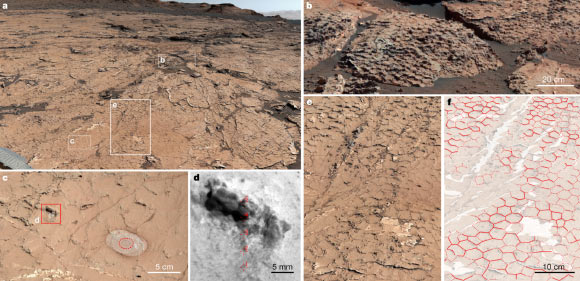New observations of mud cracks made by NASA’s Curiosity rover show that high-frequency, wet-dry cycling occurred in early Martian surface environments, indicating that the Red Planet may have once seen seasonal weather patterns or even flash floods.
Polygonal ridges on Mars: (a) general view of bedrock surrounding the rover on sols 3,154 to 3,156 showing widespread polygonal ridges; (b) close-up showing ‘stepped’ exposure of polygons within large bedrock blocks; (c) view of bedrock with polygons and locations of ChemCam analysis on ridge (red rectangle) and APXS analysis on smooth host bedrock (dotted circle); (d) remote micro-image of cemented ridge with spots analyzed by ChemCam (reticles 1 to 5), highlighting details of nodular texture; (e, f) bedrock with polygonal pattern (e) and interpretative overlay (f) that shows prominent ridges (solid red lines), less certain ridges (dotted red lines) and cross-cutting later-stage Ca-sulfate-filled veins (white areas). Image credit: Rapin et al., doi: 10.1038/s41586-023-06220-3.
Mars has a well preserved sedimentary record that dates as far back as 4.3 billion years ago and perhaps earlier.
The early presence of habitable environments and even perennially wet surface environments has been well established.
Little is known, however, about short-term episodicity and potential periodicity in early hydroclimate regimes.
Post-depositional processes driven by short-term fluctuations in a hydroclimate regime mostly leave surficial imprints (for example, mud cracks).
Although these surficial imprints are prone to erosion, they are nonetheless critical for understanding past surface environments.
More generally, widely diverging models of the seasonality and episodicity of early Mars’s water cycle and aridity are poorly constrained.
“The new exciting observations of mature mud cracks are allowing us to fill in some of the missing history of water on Mars,” said senior author Dr. Nina Lanza, principal investigator of the ChemCam instrument onboard the Curiosity rover and a researcher with Los Alamos National Laboratory.
“How did Mars go from a warm, wet planet to the cold, dry place we know today?”
“These mud cracks show us that transitional time, when liquid water was less abundant but still active on the Martian surface.”
“These features also point to the existence of wet-dry environments that on Earth are extremely conducive to the development of organic molecules and potentially life.”
“Taken as a whole, these results a giving us a clearer picture of Mars as a habitable world.”
After years of exploring terrain largely comprised of silicates, Curiosity entered a new area filled with sulfates, marking a major environment transition.
In this new environment, Dr. Lanza and colleagues found a change in mud crack patterns, signifying a change in the way the surface would have dried.
This indicates that water was still present on the surface of Mars episodically, meaning water could have been present for a time, evaporated, and repeated until polygons, or mud cracks, formed.
“A major focus of the Curiosity mission, and one of the main reasons for selecting Gale Crater, is to understand the transition of a warm and wet ancient Mars to a cold and dry Mars we see today,” said Dr. Patrick Gasda, also from Los Alamos National Laboratory.
“The rover’s drive from clay lakebed sediments to drier non-lakebed and sulfate-rich sediments is part of this transition.”
On Earth, initial mud cracks in mud form a T-shaped pattern, but subsequent wetting and drying cycles cause the cracks to form more of a Y-shaped pattern, which is what Curiosity observed.
Additionally, the rover found evidence that the mud cracks were only a few centimeters deep, which could mean that wet-dry cycles were seasonal, or may have even occurred more quickly, such as in a flash flood.
These findings could mean that Mars once had an Earth-like wet climate, with seasonal or short-term flooding, and that Mars may have been able to support life at some point.
“What’s important about this phenomenon is that it’s the perfect place for the formation of polymeric molecules required for life, including proteins and RNA, if the right organic molecules were present at this location,” Dr. Gasda said.
“Wet periods bring molecules together while dry periods drive reactions to form polymers.”
“When these processes occur repeatedly at the same location, the chance increases that more complex molecules formed there.”
The team’s findings were published this week in the journal Nature.
_____
W. Rapin et al. 2023. Sustained wet-dry cycling on early Mars. Nature 620, 299-302; doi: 10.1038/s41586-023-06220-3




